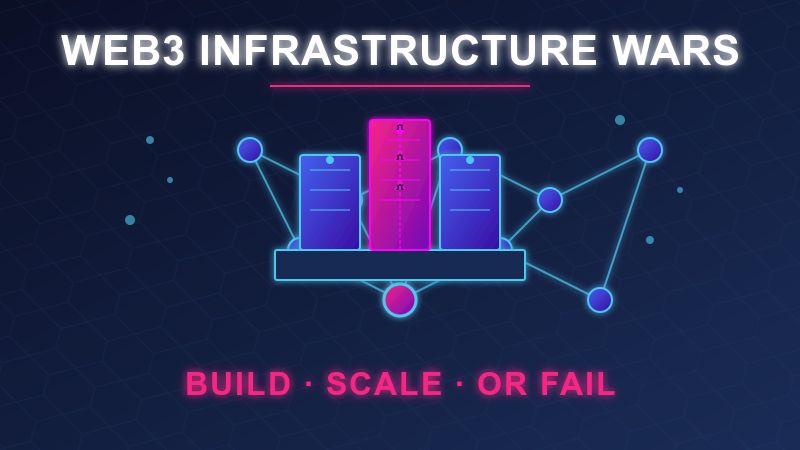
In the rapidly evolving Web3 landscape, choosing the right infrastructure provider can make or break your project. While the promise of decentralization has captured imaginations worldwide, the technical complexity of building and scaling Web3 applications remains a significant hurdle. This is where Web3 infrastructure providers come in – offering the essential building blocks developers need to create resilient, scalable decentralized applications.
The Explosive Growth of Web3 Infrastructure
The Web3 infrastructure market has seen remarkable growth, with funding reaching $7.1 billion in 2023, a 147% increase from 2022. As adoption increases, the number of active blockchain developers has surpassed 23,000 as of Q1 2024, highlighting the expanding ecosystem’s need for robust infrastructure solutions.
Why Your Choice of Web3 Infrastructure Provider Matters
Your infrastructure provider isn’t just a technical decision – it’s a strategic one that impacts:
- Development speed: The right provider can reduce time-to-market by 60-70%
- Scalability: As transaction volumes grow (with some networks now processing over 50 million daily transactions), your infrastructure must scale accordingly
- Reliability: With average financial losses from downtime estimated at $5,600 per minute, reliability is non-negotiable
- Cost efficiency: Infrastructure costs typically represent 15-30% of total Web3 project expenses
Key Criteria for Selecting Your Web3 Infrastructure Provider
1. Network Support and Multi-Chain Capabilities
The Reality: 78% of dApps now operate across multiple blockchains, according to a 2024 industry survey.
Look for providers that support your target networks and offer unified APIs that abstract away chain-specific complexities. Leading providers now support an average of 15+ networks, but the breadth of features can vary significantly across chains.
Key Questions to Ask:
- Which networks does the provider support with production-ready infrastructure?
- How quickly do they add support for emerging networks?
- Do they offer consistent feature parity across all supported chains?
2. Node Infrastructure and Performance
The Statistics: Node response times can vary by 300-500ms between providers, which becomes critical at scale when processing millions of requests.
Evaluate providers based on their node architecture, geographic distribution, and performance metrics. Premium providers maintain 99.9%+ uptime with response times under 200ms.
Key Performance Indicators:
- Average response time and consistency
- Request success rates
- Geographic distribution and redundancy
- Support for WebSockets and other connection methods
3. API Quality and Developer Experience
The Impact: Development speed can increase by up to 40% with well-designed APIs and comprehensive documentation.
The quality of APIs, SDKs, and documentation dramatically impacts development velocity. Look for providers with clean, intuitive interfaces, comprehensive SDKs for your preferred languages, and exceptional documentation.
Developer-Friendly Features to Consider:
- Normalized responses across chains
- Robust error handling and detailed error messages
- Comprehensive method support
- Well-maintained SDKs for major programming languages
- Interactive API explorers and code examples
4. Reliability and Support
Critical Insight: According to a 2024 survey, 67% of Web3 projects have experienced significant disruptions due to infrastructure issues.
When blockchain applications handle millions in assets, reliability becomes paramount. Evaluate SLAs, support tiers, and the provider’s track record during network congestion or outages.
Reliability Checklist:
- Published uptime statistics and SLAs
- Redundancy and failover mechanisms
- Support response times and availability
- Historical performance during network stress events
5. Scaling Capabilities and Pricing Models
Cost Factors: Enterprise-grade providers typically charge $0.15-0.40 per 100,000 requests, with volume discounts available.
As your application grows, infrastructure costs can escalate quickly. Understand the provider’s pricing model and how it aligns with your growth trajectory.
Pricing Considerations:
- Request-based vs. subscription pricing
- Tiered pricing models and volume discounts
- Additional costs for premium features or dedicated infrastructure
- Scaling limitations and throttling policies
The Leading Web3 Infrastructure Providers in 2024
While specific recommendations depend on your project’s unique requirements, several providers have established strong reputations:
- RedSwitches: Delivering high-performance bare metal servers with 99.9% uptime guarantee and specialized Web3 infrastructure solutions that reduce latency by up to 40%
- Infura: Powering over 430,000 developers with multi-chain support and enterprise-grade reliability
- Alchemy: Serving 70% of top Ethereum applications with advanced developer tools
- QuickNode: Supporting 16+ blockchains with globally distributed infrastructure
- Chainstack: Offering flexible deployment options across public and private clouds
- Ankr: Combining decentralized and traditional infrastructure models
Implementation Strategy: A Hybrid Approach
Many successful Web3 projects employ a hybrid approach:
- Primary Provider: Handles 80-90% of standard requests
- Secondary Provider: Serves as failover and handles specialized needs
- Optional Self-Hosted Nodes: For highly sensitive operations or custom requirements
This strategy provides 99.99% uptime while optimizing for both cost and performance.
For projects requiring maximum control and performance, providers like RedSwitches offer dedicated bare metal server solutions that can be customized specifically for Web3 workloads. Their infrastructure has been shown to reduce transaction validation times by up to 35% compared to standard cloud offerings, making them particularly valuable for high-frequency trading applications and NFT platforms experiencing sudden traffic spikes.
Common Pitfalls to Avoid
- Over-relying on free tiers: Free plans often come with strict rate limits and reduced reliability
- Ignoring archive data needs: Historical data access can become unexpectedly expensive
- Single-provider dependency: Creates a single point of failure
- Neglecting WebSocket requirements: Critical for real-time applications
- Underestimating testing needs: Development environments require their own infrastructure planning
Conclusion: Making Your Decision
Selecting the right Web3 infrastructure provider requires balancing technical requirements, budget constraints, and future growth plans. By thoroughly evaluating providers against the criteria outlined above, you’ll be well-positioned to make an informed decision that supports your project’s success.
The Web3 ecosystem continues to mature, with infrastructure providers playing a crucial role in its growth. As you build your decentralized future, remember that your infrastructure choices today will significantly impact your ability to scale, innovate, and deliver reliable experiences tomorrow.

The Hidden Business Power of Storytelling Through Books

Diamond Painting Apps & Digital Tools for 2025 Artists

Meeting Global Tastes: The Versatility of Commercial Tortilla Makers

Accelerating drug discovery through the DEL-ML-CS approach

AI in Marketing Is No Longer a Buzzword — It’s the Strategy

Benefits of Working with a Bathroom Remodeling SEO Company

The Full Guide To Penetration Testing

Pixel 10 Pro Fold Case: Why Choose Aramid Fiber?








